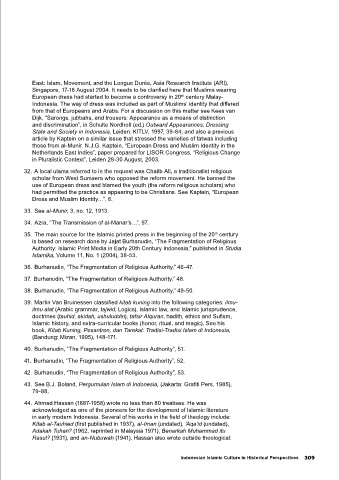Page 318 - INDONESIA ISLAMIC CULTURE
P. 318
September and 7, October 1907; 5, January and 4, February 1908. See Hamzah, East: Islam, Movement, and the Longue Durée, Asia Research Institute (ARI),
Al-Imam: Its Role…, 73-9; Laffan, Islamic Nationhood…, 150, 255-6. This school Singapore, 17-18 August 2004. It needs to be clarified here that Muslims wearing
did not last long, however. Faced with the opposition of the old traditionalists, it was European dress had started to become a controversy in 20 century Malay-
th
relocated to Riau under the new name Madrasah al-Ahmadiyah, and consisted up Indonesia. The way of dress was included as part of Muslims’ identity that differed
to 1909. from that of Europeans and Arabs. For a discussion on this matter see Kees van
Dijk, “Sarongs, jubbahs, and trousers: Appearance as a means of distinction
22. Deliar Noer, The Modernist Muslim Movement in Indonesia 1900-1942, (Kuala and discrimination”, in Schulte Nordholt (ed.) Outward Appearances: Dressing
Lumpur: Oxford University Press, 1973), 30. Meanwhile at the Malay regions which State and Society in Indonesia, Leiden: KITLV, 1997, 39-84; and also a previous
are now Malaysia and Singapore, reformism also had a strong impact. In the field article by Kaptein on a similar issue that stressed the varieties of fatwas including
of publishing, this can be seen from the rise of magazines and newspapers after those from al-Munir. N.J.G. Kaptein, “European Dress and Muslim Identity in the
al-Imam had discontinued its publication. In 1911, Haji Abbas bin Toha, an al-Imam Netherlands East Indies”, paper prepared for LISOR Congress, “Religious Change
exponent, began to publish the reform magazine Neratja. In Penang, the reform in Pluralistic Context”, Leiden 28-30 August, 2003.
magazines al-Ikhwan and Saudara were also published. These magazines, like
other magazines and publications continued al-Imam’s reform spirit. See Roff, 32. A local ulama referred to in the request was Chatib Ali, a traditionalist religious
Bibliography of Malay…, 11-4; Roff, The Origin of Malay…, 75-87. scholar from West Sumaera who opposed the reform movement. He banned the
use of European dress and blamed the youth (the reform religious scholars) who
23. Ahmat bin Adam, The Vernacular Press and the Emergence of Modern had permitted the practice as appearing to be Christians. See Kaptein, “European
Indonesian Consciousness (1855-1913), (Ithaca: Southeast Asian Program Cornell Dress and Muslim Identity…”, 6.
University, 1995), 140. It must be clarified here that al-Munir was the first magazine
published in Indonesia after al-Imam. In Malaysia, Neratja emerged in 1911 and 33. See al-Munir, 3, no. 12, 1913.
Tunas Melayu in 1913, both by H. Abbas, an ex editor of al-Imam. See Roff,
Bibliography of Malay…, 7-8. 34. Azra, “The Transmission of al-Manar’s…”, 97.
th
24. Noer, The Modernist Muslim…, 35. For a discussion on al-Munir’s founding of, 35. The main source for the Islamic printed press in the beginning of the 20 century
see also Hamka (Haji Abdul Malik Karim Amrullah), Ajahku: Riwajat hidup Dr. is based on research done by Jajat Burhanudin, “The Fragmentation of Religious
H. Abd. Karim Amrullah dan perdjuangan kaum agama di Sumatera, (Djakarta: Authority: Islamic Print Media in Early 20th Century Indonesia,” published in Studia
Widjaja, 1958); Alfian, Muhammadiyah: The Political Behavior of a Muslim Islamika, Volume 11, No. 1 (2004), 38-53.
Modernist Organization under Dutch Colonialism, (Yogyakarta: UGM Press, 1989), 36. Burhanudin, “The Fragmentation of Religious Authority,” 46-47.
108; Tamar Djaja, Pusaka Indonesia: Riwayat Hidup Orang-orang Besar Tanah Air,
Djakarta: Bulan Bintang, 1966), Vol. II, 700; Syamsuri Ali, “Al-Munir dan Wacana 37. Burhanudin, “The Fragmentation of Religious Authority,” 48.
Pembaharuan Pemikiran Islam 1911-1915”, Padang: MA Thesis IAIN Imam Bonjol,
1997, 26. 38. Burhanudin, “The Fragmentation of Religious Authority,” 49-50.
25. Azyumardi Azra, “The Transmission of al-Manar’s Reformism to the Malay- 39. Martin Van Bruinessen classified kitab kuning into the following categories: ilmu-
Indonesian World: the Cases of al-Imam and al-Munir”, Studia Islamika, Vol. 6/3, ilmu alat (Arabic grammar, tajwid, Logics), Islamic law, and Islamic jurisprudence,
1999, 92. doctrines (tauhid, akidah, ushuluddin), tafsir Alquran, hadith, ethics and Sufism,
Islamic history, and extra-curricular books (honor, ritual, and magic). See his
26. Mahmud Yunus, Sejarah Pendidikan Islam di Indonesia, (Jakarta: Mutiara, 1979), book, Kitab Kuning, Pesantren, dan Tarekat: Tradisi-Tradisi Islam di Indonesia,
157. (Bandung: Mizan, 1995), 148-171.
27. See al-Munir 1, no. 1, 1911. See also Azra, “The Transmission of al-Manar’s…, 94. 40. Burhanudin, “The Fragmentation of Religious Authority”, 51.
28. See al-Munir 3, no. 2, 1913. 41. Burhanudin, “The Fragmentation of Religious Authority”, 52.
29. For the contents of these two magazines see Roff, The Origin of Malay…, 56- 42. Burhanudin, “The Fragmentation of Religious Authority”, 53.
59; Hamzah, Al-Imam: Its Role in Malay Society…, 21-22; Noer, The Modernist
Muslim…, 39-40; Ali, “Al-Munir dan Wacana Pembaharuan”…. 43. See B.J. Boland, Pergumulan Islam di Indonesia, (Jakarta: Grafiti Pers, 1985),
79-88.
30. Jutta E. Bluhm, “A preliminary statement on the dialogue between the reform
magazine al-Manar and the Malayo-Indonesian World”, Indonesia Circle 32, 1983, 44. Ahmad Hassan (1887-1958) wrote no less than 80 treatises. He was
35-42. acknowledged as one of the pioneers for the development of Islamic literature
in early modern Indonesia. Several of his works in the field of theology include:
31. N.J.G. Kaptein, “Southeast Asian Debates and Middle Eastern Inspiration: Kitab al-Tauhied (first published in 1937), al-Iman (undated), ’Aqa’id (undated),
European Dress in Minangkabau at the Beginning of the Twentieth Century”, in Adakah Tuhan? (1962, reprinted in Malaysia 1971), Benarkah Muhammad itu
Eric Tagliacozzo (ed.) Proceedings Workshop Southeast Asia and the Middle Rasul? (1931), and an-Nubuwah (1941). Hassan also wrote outside theological:
308 Indonesian Islamic Culture in Historical Perspectives Indonesian Islamic Culture in Historical Perspectives 309

